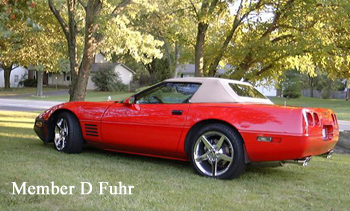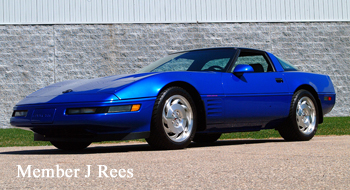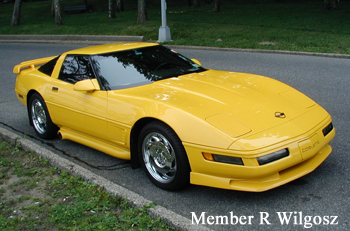As printed in For Vettes Only in October 1993.
 The Corvette has turned 40, but the fun never stops. The milestone one-millionth Corvette rolled off the assembly line on July 2, 1992. Now a refined LT1 engine, an all-new interior, improvements in comfort, and added safety features are driving the Corvette toward its second million.
The Corvette has turned 40, but the fun never stops. The milestone one-millionth Corvette rolled off the assembly line on July 2, 1992. Now a refined LT1 engine, an all-new interior, improvements in comfort, and added safety features are driving the Corvette toward its second million.The 5.7-liter LT1 small block V8 is even more satisfying to drive in 1194 with the introduction of sequential fuel injection. Sequential fuel injection optimizes combustion by precisely matching fuel delivery to each cylinder’s intake stroke, firing the individual injectors in sequence with the LT1’s firing order. This sophisticated system provides a smoother idle, better drivability, and lower emissions. The second-generation LT1’s new SFI system incorporates a mass airflow sensor (MAF) in place of the speed-density system used on previous LT1 engines.
GM’s highly regarded 4L60-E-4-speed automatic overdrive transmission is standard equipment on LT1-powered coupes and convertibles in 1994. The 4L60-E combines the durable and reliable design of the 4L60 with the precision and flexibility of electronic controls. The Corvette’s Powertrain Control Module acts as an interface between the engine and transmission to provide the feel of a “seamless” powertrain.
The Corvette interior is completely redesigned for 1994, with new  carpeting, new door trim panels, new seats, a new two-spoke steering wheel, and a new look for the instrument panel and console. The standard reclining bucket seats and optional articulated Sport seats both have leather-seating areas exclusively. The new seats are designed for easier entry and exit.
carpeting, new door trim panels, new seats, a new two-spoke steering wheel, and a new look for the instrument panel and console. The standard reclining bucket seats and optional articulated Sport seats both have leather-seating areas exclusively. The new seats are designed for easier entry and exit.
The 1994 Corvette interior features include a passenger’s side air bag and knee bolster as standard equipment. The door panels have storage space in the armrests, and the driver’s window has an “Express Down” feature. The instrument panel’s white graphics turn to tangerine at night.
Corvette engineers have improved the 1994 model’s ride quality by reducing the recommended tire pressure for Corvettes coupes to 30psi and lowering the spring rates used with the optional Selective Ride Control system. Shock rates have also been recalibrated.
ZR-1 coupes are outfitted with new five-spoke non-directional aluminum wheels (17 x 9.5 front, 17 x 11 rear) in 1994. Corvette convertibles have a bright outlook in 1994 with the introduction of a heated glass backlight.
Two new exterior colors are available: Admiral Blue and Copper metallic.
 The Corvette has long been a showcase for GM’s leading-edge-technology. Its sophisticated systems include Passive Keyless Entry System (PKE), PASS-key theft-deterrent system, and Bosch ABS/ASR anti-lock braking and traction control strategy. Chevrolet’s all-weather Corvette has a lengthy list of standard-equipment including the 300hp 5.7-liter V8 and 4-speed automatic overdrive transmission (the ZF 6-speed manual is a no-cost option), dual air bags, 4-wheel independent suspension, 4-speed ABS, disc brakes, power windows and door lock, dual electric out-side rearview mirrors, cruise control, a heated rear window defogger, an AM/FM stereo with seek, scan and cassette, 17-inch aluminum wheels and high-performance Goodyear eagle GS-C tires.
The Corvette has long been a showcase for GM’s leading-edge-technology. Its sophisticated systems include Passive Keyless Entry System (PKE), PASS-key theft-deterrent system, and Bosch ABS/ASR anti-lock braking and traction control strategy. Chevrolet’s all-weather Corvette has a lengthy list of standard-equipment including the 300hp 5.7-liter V8 and 4-speed automatic overdrive transmission (the ZF 6-speed manual is a no-cost option), dual air bags, 4-wheel independent suspension, 4-speed ABS, disc brakes, power windows and door lock, dual electric out-side rearview mirrors, cruise control, a heated rear window defogger, an AM/FM stereo with seek, scan and cassette, 17-inch aluminum wheels and high-performance Goodyear eagle GS-C tires.
|
'94 VETTE FACTS
|
|
|
VEHICLE IDENTIFICATION NUMBER
|
Base - 1G1YY[2/3]2P9R5100001 to 1G1YY[2/3]2P9R5122882. ZR-1 1G1YZ22j9R5800001 to 1G1YZ22J9R5800448. The first symbol (1) indicates US built. The second symbol (G) indicates GM product. The third symbol (1) indicates Chevrolet. The fourth and fifth symbols were YY for the Base Corvette or YZ for the Corvette ZR-1. The sixth symbol indicates body style: 2=Two door hatchback and 3=Two-door convertible. The seventh symbol indicates the restraint code 2=Active manual belts with driver and passenger inflatable restraint system. The eighth symbol indicates engine: P=RPO LT1 5.7-liter Multiport-Fuel-Injection (MfI) Chevrolet/GM of Canada V8 and J=RPO LT5 5.7-liter MFI V8. The ninth symbol is a check digit that varies. The 10th symbol indicates model year R-1994. The llth symbol indicates the assembly 5=Bowling Green. The last six symbols indicate the sequential production number starting with 100001 and 800001 for Zr-1s.
|
|
ENGINE
|
BASE ENGINE
Type: RPO LT1 V-8 90-degree over head
valve.
Cast iron block and head
Bore and stroke: 4.00 x 3.48 in.
Displacement: 350 cid 5.7 liters
Compression ratio: 10.5:1
Brake hp: 300 at 5000 rpm
Torque: 340 lbs-ft. at 3600 rpm
Five main bearings
Aluminum cylinder head
Hydraulic valve lifters
Induction: Sequential multiport-fuel
injection
ZR-1 ENGINE
Type: RPO LT5 V-8 90-degree over head
valve with four valves per cylinder.
Four over-head camshafts
Cast iron block and head
Bore and stroke: 4.00 x 3.48 in.
Displacement: 350 cid 5.7 liters
Compression ratio: 11.0:1
Brake hp: 3405 at 5800 rpm
Torque: 385 lbs-ft. at 5200 rpm
Five main bearings
Aluminum cylinder head
Hydraulic valve lifters
Induction: Sequential multiport-fuel injection
|
|
VITAL STATS
|
Coupe
Original Price: $36,185
Production: 17,984
Wheelbase: 96.2 in.
Length: 178.5 in.
Tires: Front - P255/45AR-17 Rear – P285/40ZR-17 Goodyear Eagle GT
Convertible
Original Price: $42,960
Production: 5,346
Wheelbase: 96.2 in.
Length: 178.5 in.
Tires: Front - P255/45AR-17 Rear – P285/40ZR-17 Goodyear Eagle GT
ZR-1
Original Price: $67,443
Production: 448
Wheelbase: 96.2 in.
Length: 178.5 in.
Tires: Front - P255/45AR-17 Rear – P315/35ZR-17 Goodyear Eagle GT
|
|
COOL STUFF
|
• National Corvette Museum opened to the public on 9/2/1994
• All seats were leather.
• Rear window for convertibles was changed from plastic to glass
and included an in-glass defogger grid.
|